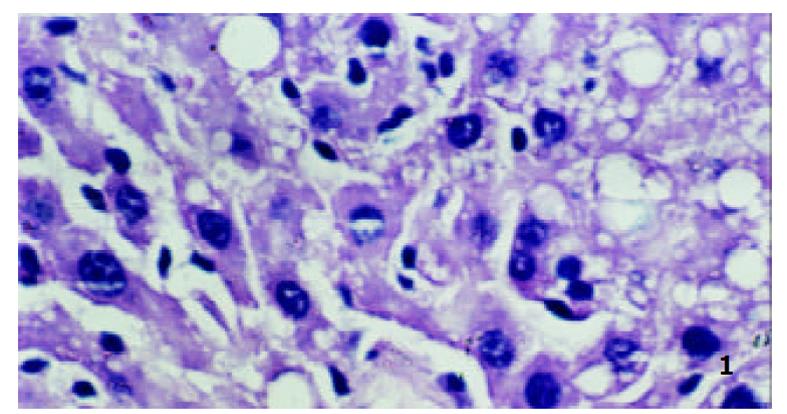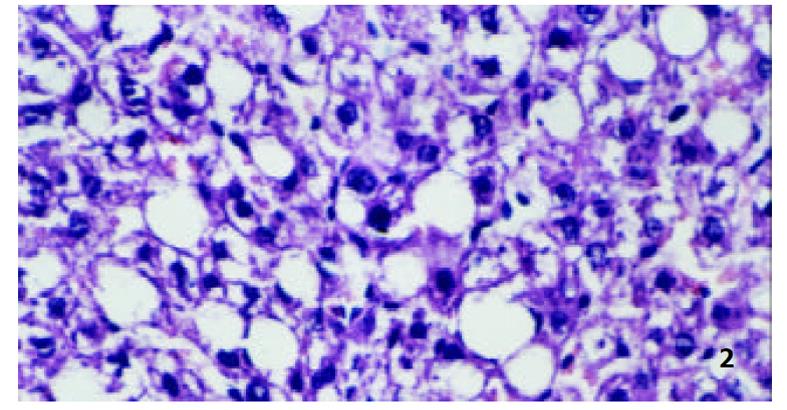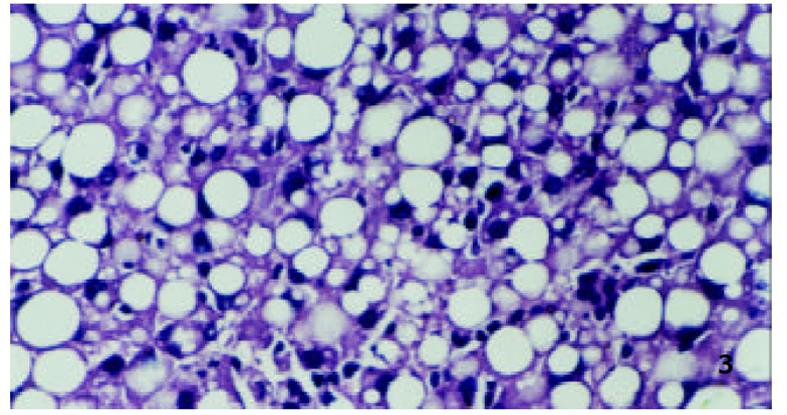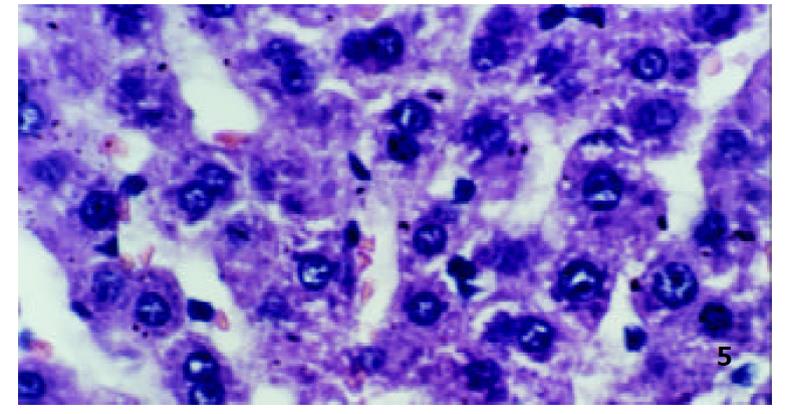修回日期: 2002-10-20
接受日期: 2002-10-29
在线出版日期: 2003-08-15
为酒精性脂肪肝的研究提供有价值的模型.
采用高浓度酒每日灌胃, 同时改进饲料配方, 增加食物中脂肪含量、增加铁剂的方法.
造模2 wk后可见肝脏轻微脂肪沉积, 3 wk后呈中度脂肪肝, 4 wk后为重度脂肪肝病变; 与对照组相比, 肝指数明显增大 (模型组4.9±1.1; 对照组4.0±0.6, P<0.05), 具有统计学意义.
本造模方法与人类酒精性脂肪肝病变类似, 方法简单易行、实验周期短, 结论明确, 一般实验室均可进行.
引文著录: 冯志强, 沈志祥, 谭诗云, 罗和生, 漆楚波, 郭洁, 李海霞. 大鼠急性酒精性脂肪肝造模方法的改进. 世界华人消化杂志 2003; 11(8): 1189-1192
Revised: October 20, 2002
Accepted: October 29, 2002
Published online: August 15, 2003
To provide a valuable model for the study on acute alcoholic fatty liver.
Thirty Wistar male rats were randomized into two groups: model group (group 1, intragastric infusion of spirits, fed with high fat and iron diet), control group (group 2, intragastric infusion of saline, fed with common diet). Some rats were sacrificed after 2 and 3 weeks to evaluate the process of alcoholic fatty liver formation. All rats were sacrificed at the end of the fourth week.
Slight fatty deposition was observed at the end of 2nd week after the experiment and moderate fatty deposition at the 3 rd week and severe fatty deposition at the 4 th week. In comparison with control group, the liver mass index was increased in the model group. There was a statistically significant difference between the two groups.
The lesion of the acute alcoholic fatty liver in model rats is similar to that in humans. The experiment is very simple and the experiment cycle is short and the conclusion is clear.
- Citation: Feng ZQ, Shen ZX, Tan SY, Luo HS, Qi CB, Guo J, Li HX. Improvement of induction method of acute alcoholic fatty liver model in rats. Shijie Huaren Xiaohua Zazhi 2003; 11(8): 1189-1192
- URL: https://www.wjgnet.com/1009-3079/full/v11/i8/1189.htm
- DOI: https://dx.doi.org/10.11569/wcjd.v11.i8.1189
目前, 酒精性脂肪肝已经成为国内外的一大研究热点. 经典的酒精性脂肪肝模型为Liber-Decarli模型, 该方法简便易行、费用低、形成率高并且稳定性好, 但由于大鼠厌酒, 故不能保证大鼠较恒定的酒精摄入量, Tsukamato-French大鼠模型虽能控制实验动物的酒精摄入, 但制作该模型需要一些技术上的训练和特殊设备, 价格昂贵, 给人们的研究带来不便. 因此, 我们在他们实验的基础上, 采用了高浓度酒每日灌胃, 同时改进饲料配方的方法建立了大鼠酒精性脂肪肝模型, 并对结果进行了病理组织学观察, 以期为酒精性脂肪肝的研究提供有价值的模型.
武汉市实验动物中心提供的体重150-200 g同批♂Wistar大鼠30只, 按体重大小排序为1, 2, 3, ......30, 再利用随机数字表, 将随机数字为单号者分入1组(模型组), 双号者归入2组(对照组). Mettler AE200分析天平, 日本Olympus显微镜. 采用普通饲料: 猪油 = 85: 15, 每1000 g饲料中加入15 g硫酸亚铁; 充分混匀, 制成成型饲料, 60 °C烤干.
模型组大鼠, 前3 d先饮用15% (v/v)二锅头酒(北京双庆和酒业有限责任公司生产, GB10781.2-89), 第4天起再按15 ml/kg灌服52% (v/v)二锅头酒, 每日上午一次; 同时给予上述饲料, 自由饮水. 对照组则灌服同等剂量生理盐水, 自由饮水, 给予普通饲料. 2 wk、3 wk后每组各处死1只, 以动态观察模型的变化. 第4周称重, 断颈处死所有大鼠, 立即取出肝脏, 4 °C生理盐水反复冲洗4-5次, 称全肝重量, 选最大肝叶沿最长径取肝组织一块, 10%中性甲醛固定, 石蜡包埋, 常规切片, HE染色, 检查由湖北省肿瘤医院病理科完成.
统计学处理 数据统计分析采用t检验, 用SAS 8.1软件包进行统计分析, 以P<0.05为有统计学差异.
模型组大鼠灌服白酒后, 绝大部分行动迟缓, 行走不稳, 重者醉倒嗜睡, 对外界刺激的反应明显减弱, 甚至没有反应, 大约35-60 min后逐渐恢复正常, 进食量及饮水量明显少于对照组, 皮毛不整, 欠光泽. 对照组大鼠皮毛光泽柔顺, 行动敏捷, 对外界环境的刺激反应迅速, 进食量及饮水量正常. 体重变化见表1. 模型组有2只因灌胃误呛入肺导致化学性肺炎, 经抢救无效而死亡, 对照组有3只误呛, 经抢救全部存活, 另外, 每组各有1只因灌胃不慎致胃穿孔而死亡.
计算方法: 肝指数=肝湿重/大鼠体重(见表2).
对照组大鼠肝脏色泽正常, 被膜光泽. 模型组大鼠肝脏外观呈弥漫性肿大, 边缘稍钝, 触之如面团, 有油腻感, 压迫时可出现凹陷, 表面色泽较苍白, 部分略带灰黄色. 切面呈淡黄色, 甚至苍白色.
模型组: 2 wk后, 可见大鼠肝脏出现轻微脂肪变性, 部分炎性细胞浸润(图1); 3 wk后, 表现为中度脂肪肝, 较多炎性细胞浸润(图2); 而4 wk后, 可见重度脂肪变性, 肝细胞索排列紊乱, 肝细胞肿胀呈气球样变, 细胞内充满大小不一的脂滴, 胞质疏松, 其内可见大小不等、数量不一的脂肪空泡以及水样变性, 细胞核被挤向一边, 呈印戒状. 肝细胞的脂肪变性以肝小叶中央区最为明显, 可见, 酒精对大鼠机体的影响是受时间、剂量的影响的, 随着给酒时间的延长、酒精摄入量的增加, 酒精对机体的影响亦会随之加大, 所引起的肝脏脂肪变性也越来越严重(图3、图4). 对照组: 肝小叶结构清晰, 肝细胞索排列整齐, 肝细胞大小较一致, 胞核居中, 胞质淡红色, 在中央静脉区偶可见少数散在脂滴(图5).
近几年来, 随着人民生活水平的提高, 饮酒或酗酒者明显增加, 由此所引起的酒精性脂肪肝的发病率也随之上升. 酒精性脂肪肝的研究已成为当前一大研究热点. 为深入研究酒精性脂肪肝的发病机制, 寻找有效的治疗和预防手段, 需要建立一个较理想而经济实用的动物模型.
经典的模型为Liber-Decarli模型, 由于其简便易行、费用低、形成率高及稳定性好而受到青睐, 但由于大鼠厌酒, 故而不能保证大鼠较恒定的酒精摄入量, Tsukamato-French大鼠模型虽能控制实验动物的酒精摄入, 但制作该模型需要一些技术上的训练如胃内导管的植入、维持, 以及保证24 h持续注入酒精所需的特殊设备, 价格昂贵, 给人们的研究带来不便. 范建高et al [1]用高脂饮食加60%的酒精15ml/kg灌胃, 2次/d, 在造模3 mo后出现轻至中度肝细胞脂肪变. 徐正婕et al [2]造模8 wk出现肝细胞脂肪变及酒精性肝炎样改变. 薄爱华et al [3]的实验模型周期也较长, 林红et al [4]的实验模型虽然周期较短, 但需每日灌胃3次, 操作比较烦琐, 且易造成实验动物的意外死亡. 他们的研究表明, 要造成进行性酒精性肝损伤, 必须给动物过量酒精, 并维持血中持续性高浓度酒精含量. 国内外学者已证实, 过量铁对人体所有的细胞均有毒害作用. 铁的毒性作用主要是在启动和催化氧自由基中起重要作用, 最明显的机制为Fenton反应 (haber-weiss反应), 反应生成大量活跃的OH.自由基, 从而损伤线粒体, 导致肝脏的损伤[5,6]; 酒精性脂肪肝时, 肝铁含量增加, 肝铁可进一步增强肝组织的脂质过氧化损伤, 从而加重脂肪肝[7-18]. 实验证实, 增加肝铁含量会导致巨噬细胞对肝脏的毒害作用[19]; 铁和酒精具有协同毒性作用[20]. 白玉et al [21]的研究表明, 减少肝组织中铁的含量则能有效地减轻脂质过氧化损伤. 因此, 本实验参照酒精性脂肪肝的发病机制[22-24]改进了饲料配方, 利用铁超载的肝毒性来抑制肝酶活性, 影响乙醇代谢以促进酒精性肝损伤的发生和发展.
肝脏是脂质代谢的中心. 长期进食高脂饮食时, 肝脏从血液中摄取脂肪酸合成TG(甘油三脂)也相应增加, 当肝脏合成TG多于肝细胞将其转运出肝时, TG则沉积于肝细胞内, 从而形成脂肪肝. 研究证明: 高脂低碳水化合物饮食较低脂高碳水化合物饮食更易促进脂肪肝的形成[25-29], 国内学者[30]研究证实, 高脂饮食可加重肝脏的负担, 明显增加脂质在肝脏的沉积, 从而促进脂肪肝的形成. 故而本实验改用高脂饮食, 以促进脂肪肝的快速形成.
总之, 我们认为, 本造模方法与人类酒精性脂肪肝病变类似, 实验周期较短, 造模方法简单易行, 一般实验室均可进行, 为今后酒精性脂肪肝的研究提供了较有价值的动物模型.
| 5. | Tomeckova V, Barnova E, Guzy J, Chavkova Z, Marekova M, Dubayova K, Kusnir J. Fe2+-induced oxidative processes in the liver mitochondria of rats. Bratisl Lek Listy. 2000;101:213-218. |
| 6. | Boireau A, Marechal PM, Meunier M, Dubedat P, Moussaoui S. The anti-oxidant ebselen antagonizes the release of the apoptogenic factor cytochrome c induced by Fe2+/citrate in rat liver mitochondria. Neurosci Lett. 2000;289:95-98. [DOI] |
| 7. | Djuric Z, Potter DW, Taffe BG, Strasburg GM. Comparison of iron-catalyzed DNA and lipid oxidation. J Biochem Mol Toxicol. 2001;15:114-119. [PubMed] [DOI] |
| 8. | Anderson D, Yardley-Jones A, Hambly RJ, Vives-Bauza C, Smykatz-Kloss V, Chua-Anusorn W, Webb J. Effects of iron salts and haemosiderin from a thalassaemia patient on oxygen radical damage as measured in the comet assay. Teratog Carcinog Mutagen. 2000;20:11-26. [DOI] |
| 9. | Nepomuceno MF, de Oliveira Mamede ME, Vaz de Macedo D, Alves AA, Pereira-da-Silva L, Tabak M. Antioxidant effect of dipyridamole and its derivative RA-25 in mitochondria: correlation of activity and location in the membrane. Biochim Biophys Acta. 1999;1418:285-294. [DOI] |
| 10. | Shih MK, Hu ML. UVA-induced oxidative damage to rat liver nuclei: reduction of iron ions and the relationship between lipid peroxidation and DNA damage. Mutat Res. 1999;438:125-132. [DOI] |
| 11. | Valerio LG Jr, Petersen DR. Characterization of hepatic iron overload following dietary administration of dicyclopentadienyl iron (Ferrocene) to mice: cellular, biochemical, and molecular aspects. Exp Mol Pathol. 2000;68:1-12. [PubMed] [DOI] |
| 12. | MacDonald GA, Bridle KR, Ward PJ, Walker NI, Houglum K, George DK, Smith JL, Powell LW, Crawford DH, Ramm GA. Lipid peroxidation in hepatic steatosis in humans is associated with hepatic fibrosis and occurs predominately in acinar zone 3. J Gastroenterol Hepatol. 2001;16:599-606. [DOI] |
| 13. | George DK, Goldwurm S, MacDonald GA, Cowley LL, Walker NI, Ward PJ, Jazwinska EC, Powell LW. Increased hepatic iron concentration in nonalcoholic steatohepatitis is associated with increased fibrosis. Gastroenterology. 1998;114:311-318. [DOI] |
| 14. | Brandsch C, Ringseis R, Eder K. High dietary iron concentrations enhance the formation of cholesterol oxidation products in the liver of adult rats fed salmon oil with minimal effects on antioxidant status. J Nutr. 2002;132:2263-2269. [PubMed] [DOI] |
| 15. | Aleynik MK, Leo MA, Aleynik SI, Lieber CS. Polyenylphosph-atidylcholine opposes the increase of cytochrome P-4502E1 by ethanol and corrects its iron-induced decrease. Alcohol Clin Exp Res. 1999;23:96-100. [DOI] |
| 16. | Valerio LG Jr, Petersen DR. Formation of liver microsomal MDA-protein adducts in mice with chronic dietary iron overload. Toxicol Lett. 1998;98:31-39. [DOI] |
| 17. | Tjalkens RB, Valerio LG Jr, Awasthi YC, Petersen DR. Association of glutathione S-transferase isozyme-specific induction and lipid peroxidation in two inbred strains of mice subjected to chronic dietary iron overload. Toxicol Appl Pharmacol. 1998;151:174-181. [PubMed] [DOI] |
| 18. | Hu ML, Shih MK. Ascorbic acid inhibits lipid peroxidation but enhances DNA damage in rat liver nuclei incubated with iron ions. Free Radic Res. 1997;26:585-592. [DOI] |
| 19. | Tsukamoto H, Lin M, Ohata M, Giulivi C, French SW, Brittenham G. Iron primes hepatic macrophages for NF-kappaB activation in alcoholic liver injury. Am J Physiol. 1999;277:G1240-1250. [PubMed] |
| 20. | Anghileri LJ, Esposito M, Fulcheri E, Zicca A, Cadoni A, Thouvenot P. Iron-ethanol synergism and pathological liver transformation. In Vivo. 1999;13:13-20. [PubMed] |
| 25. | Tsukada H, Wang PY, Kaneko T, Wang Y, Nakano M, Sato A. Dietary carbohydrate intake plays an important role in preventing alcoholic fatty liver in the rat. J Hepatol. 1998;29:715-724. [DOI] |
| 26. | Bailey SM, Cunningham CC. Effect of dietary fat on chronic ethanol-induced oxidative stress in hepatocytes. Alcohol Clin Exp Res. 1999;23:1210-1218. [PubMed] [DOI] |
| 27. | Delzenne NM, Hernaux NA, Taper HS. Lack of protective effect of menhaden oil supplementation on rat liver steatosis induced by a carbohydrate-rich diet. Food Chem Toxicol. 1998;36:555-561. [DOI] |
| 28. | Lindros KO, Jarvelainen HA. A new oral low-carbohydrate alcohol liquid diet producing liver lesions: a preliminary account. Alcohol Alcohol. 1998;33:347-353. [PubMed] [DOI] |













